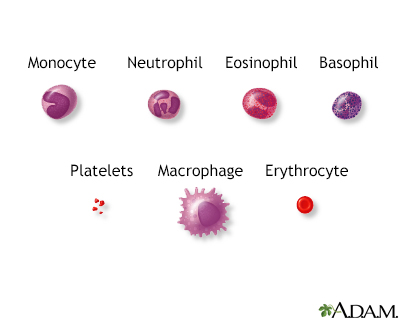Polycythemia - newborn
Neonatal polycythemia; Hyperviscosity - newborn
Polycythemia can occur when there are too many red blood cells (RBCs) in an infant's blood.
Images

Causes
The percentage of RBCs in the infant's blood is called the "hematocrit." When this is greater than 65%, polycythemia is present.
Polycythemia can result from conditions that develop before birth. These may include:
- Delay in clamping the umbilical cord
- Diabetes in the baby's birth mother
- Inherited diseases and genetic problems
- Too little oxygen reaching body tissues (hypoxia), such as from congenital heart or vascular abnormalities
- Twin-twin transfusion syndrome (occurs when blood moves from one twin to the other)
The extra RBCs can slow or block the flow of blood in the smallest blood vessels. This is called hyperviscosity. This may lead to tissue death from lack of oxygen. This blocked blood flow can affect all organs, including the kidneys, lungs, and brain.
Symptoms
Symptoms may include:
- Extreme sleepiness
- Feeding problems
- Seizures
Exams and Tests
There may be signs of breathing problems, kidney failure, low blood sugar, or newborn jaundice.
If the baby has symptoms of hyperviscosity, a blood test to count the number of RBCs will be done. This test is called a hematocrit.
Other tests may include:
- Blood gases to check oxygen level in the blood
- Blood sugar (glucose) to check for low blood sugar
- Blood urea nitrogen (BUN), a substance that forms when protein breaks down
- Creatinine
- Urinalysis
- Bilirubin
Treatment
The baby will be monitored for complications of hyperviscosity. Fluids may be given through the vein. A partial volume exchange transfusion is sometimes still done in some cases. However, there is little evidence that this is effective. It is most important to treat the underlying cause of the polycythemia.
Outlook (Prognosis)
The outlook is good for infants with mild hyperviscosity. Good results are also possible in infants who receive treatment for severe hyperviscosity. The outlook will depend largely on the reason for the condition.
Some children may have mild developmental changes. Parents should contact their health care provider if they think their child shows signs of delayed development.
Possible Complications
Complications may include:
- Death of intestinal tissue (necrotizing enterocolitis)
- Decreased fine motor control
- Kidney failure
- Seizures
- Strokes
Related Information
Fine motor controlReferences
Kliegman RM, St. Geme JW, Blum NJ, Shah SS, Tasker RC, Wilson KM. Blood disorders. In: Kliegman RM, St. Geme JW, Blum NJ, Shah SS, Tasker RC, Wilson KM, eds. Nelson Textbook of Pediatrics. 21st ed. Philadelphia, PA: Elsevier; 2020:chap 124.
Letterio J, Pateva I, Petrosiute A, Ahuja S. Hematologic and oncologic problems in the fetus and neonate. In: Martin RJ, Fanaroff AA, Walsh MC, eds. Fanaroff and Martin's Neonatal-Perinatal Medicine. 11th ed. Philadelphia, PA: Elsevier; 2020:chap 79.
Tashi T, Prchal JT. Primary and secondary erythrocytosis. In: Fish JD, Lipton JM, Lanzkowsky P, eds. Lanzkowsky's Manual of Pediatric Hematology and Oncology. 7th ed. Cambridge, MA: Elsevier Academic Press; 2022:chap 10.
BACK TO TOPReview Date: 4/28/2023
Reviewed By: Neil K. Kaneshiro, MD, MHA, Clinical Professor of Pediatrics, University of Washington School of Medicine, Seattle, WA. Also reviewed by David C. Dugdale, MD, Medical Director, Brenda Conaway, Editorial Director, and the A.D.A.M. Editorial team.

Health Content Provider
06/01/2025
|
A.D.A.M., Inc. is accredited by URAC, for Health Content Provider (www.urac.org). URAC's accreditation program is an independent audit to verify that A.D.A.M. follows rigorous standards of quality and accountability. A.D.A.M. is among the first to achieve this important distinction for online health information and services. Learn more about A.D.A.M.'s editorial policy, editorial process and privacy policy. A.D.A.M. is also a founding member of Hi-Ethics. This site complied with the HONcode standard for trustworthy health information from 1995 to 2022, after which HON (Health On the Net, a not-for-profit organization that promoted transparent and reliable health information online) was discontinued. |
The information provided herein should not be used during any medical emergency or for the diagnosis or treatment of any medical condition. A licensed medical professional should be consulted for diagnosis and treatment of any and all medical conditions. Links to other sites are provided for information only -- they do not constitute endorsements of those other sites. © 1997- 2025 A.D.A.M., a business unit of Ebix, Inc. Any duplication or distribution of the information contained herein is strictly prohibited.
